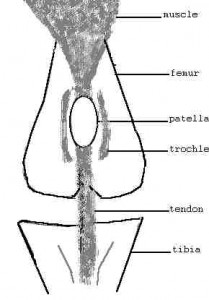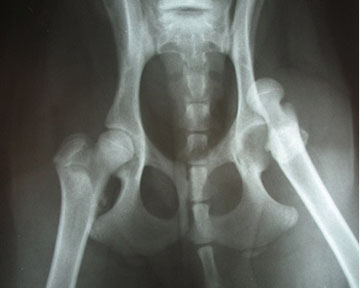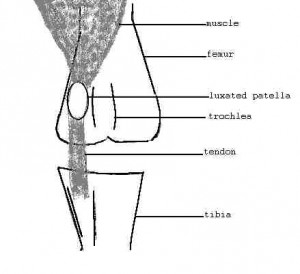Dislocations occur at a joint when the angle of the connection is displaced causing the usual function of the joint to be disrupted. You may see a lump or bump where the bones are incorrectly aligned, notice that the dog is unable to use the limb or maybe it just looks plane wrong!
As in humans, it is important not to just plough in and try to relocate the joint yourself. This is something that does need an experienced hand and it is often preferable to x-ray the joint after the relocation to ensure no vessles or nerves have been trapped within the joint.
Dislocations are incredibly painful. It may be necessary to muzzle your dog before you try to help him.
First, check the paw beyond the dislocation to see that it is still nice and warm. If the paw begins to feel cool or cold, blood flow to the limb is being compromised. If the limb does not receive enough oxygenated blood, this can be very serious so please do treat it as an emergency. You need to phone your vet immediately and have the dog seen straight away. This is NOT something that can be left until the following day.
If the limb feels warm, your immediate panic can relax a little but you still need to ring your vet immediately for advice as to whether the dog needs to be seen now, or if it can wait until the next clinic time. Allow the dog to adopt whichever is the most comfortable position for himself and certainly do not try to manipulate the dislocation. Simply support it in the position it is in – it might be that putting pillows either side of the limb will keep it still or keep it pressed towards the body to stop it moving.
If at all possible, you can use R.I.C.E. to help soothe it:
R= Rest. Keep the dog from walking on the injured limb
I= Ice. Use an ice pack or cold compresses if the dog will tolerate it.
C= Compression. As above, stabilise the joint so it’s not moving about.
E= Elevation. Raise the injured limb IF this does not alter its position.
If your dog has been given pain medication in the past (such as Metacam anti-inflammatory medication for example) then you can give an appropriate dose as previously prescribed by your vet if you still have some at home. N.B. Metacam should not be given on an empty stomach, so if the dog has not eaten you may wish to give a small snack at the same time to line the stomach. However, before giving ANY pain medication to your dog in this situation, please check with your vet as he may decide to sedate him straight away to relocate the dislocation and any food/medication he has been given prior to sedation could have an implication on the treatment your vet is able to give.
When an animal is in pain, he usually breathes more quickly.
When you breathe more quickly, you take in less oxygen.
When you have less oxygen, this can trigger shock.
Therefore, please keep an eye on 3 things:
How many breaths is he taking in 10 seconds?
How fast is his heart rate?
What colour are his gums?
If you feel that these things are increasing, he could be starting to go in to shock which is even more dangerous than the dislocation. If this is the case, please tell your vet immediately. Here is our blog on shock just in case Blog on Shock
Luxating (dislocating) patella
This condition is fairly common as far as dislocations go and owners of dogs affected with a dislocating patella can often learn to replace the kneecap themselves with veterinary instruction.
The limb is straightened at the stifle (knee) joint, and the patella slid or pushed back from its position on the inside of the joint.
Sometimes, if the patella is particularly loose, simply rubbing the extended joint is all that is needed. In affected dogs the condition is, of course, liable to recur.



